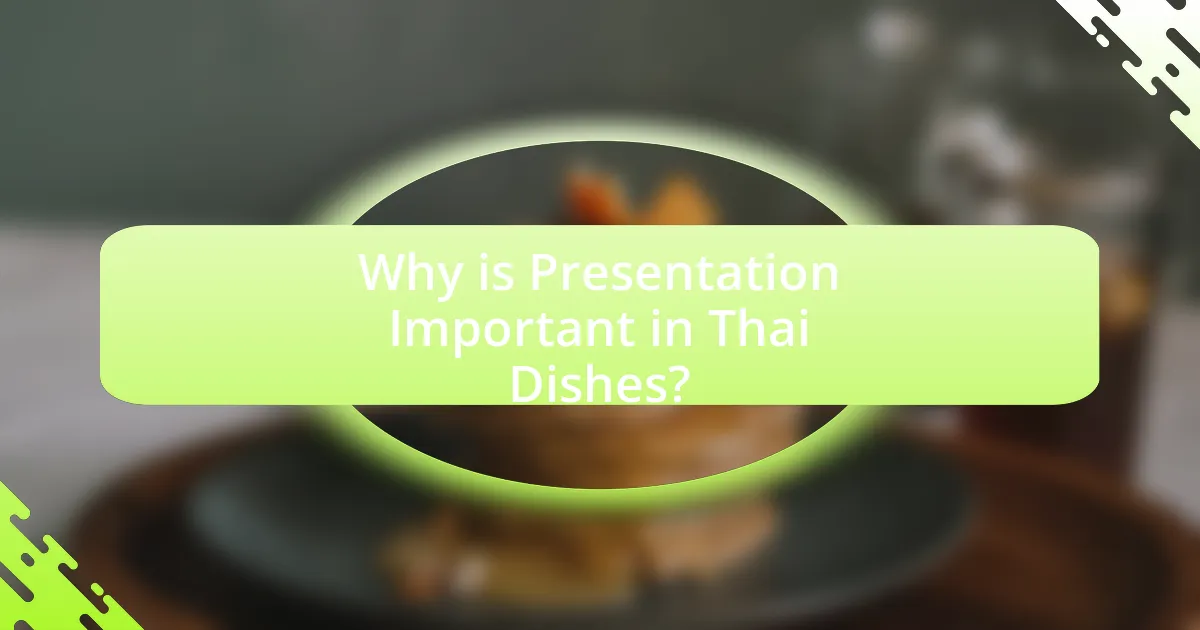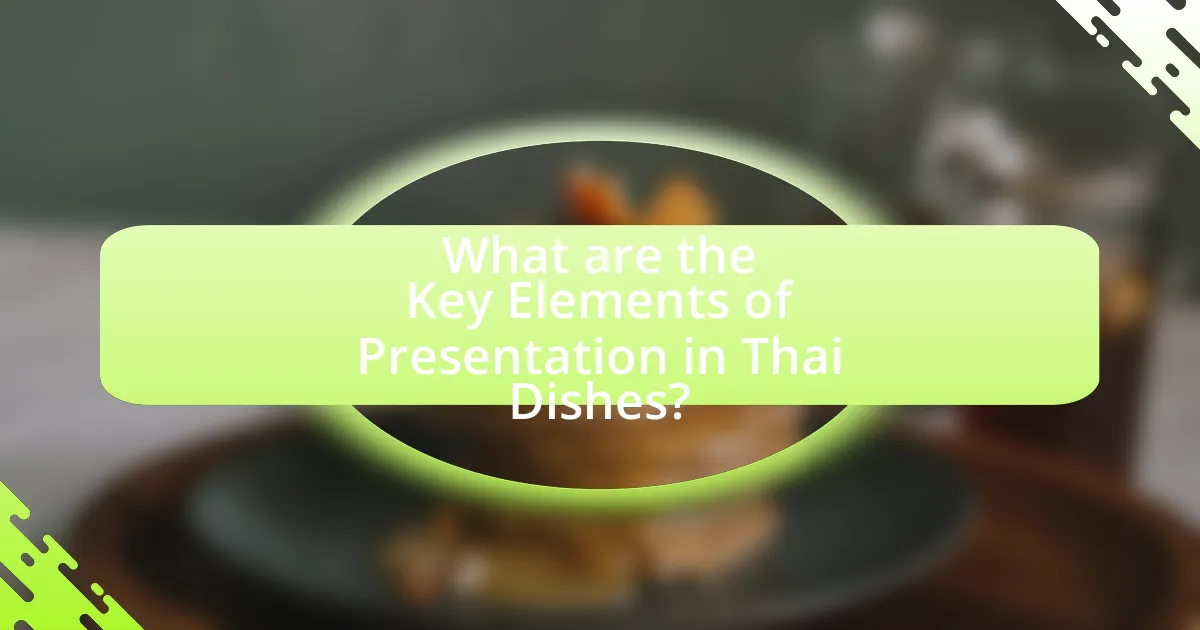The article focuses on the significance of presentation in Thai dishes, highlighting how it enhances the dining experience and reflects cultural values. It discusses the impact of visual appeal on the perception of taste and quality, emphasizing the role of vibrant colors, intricate garnishing, and balanced composition in Thai cuisine. The article also explores traditional Thai values related to food presentation, historical influences, and practical tips for improving plating skills at home, while addressing common mistakes to avoid. Overall, it underscores the importance of aesthetics in Thai culinary traditions and its effect on diners’ enjoyment and satisfaction.

Why is Presentation Important in Thai Dishes?
Presentation is important in Thai dishes because it enhances the overall dining experience and reflects the cultural significance of food in Thailand. The visual appeal of a dish can stimulate appetite and create anticipation, as Thai cuisine often emphasizes vibrant colors and artistic arrangements. For instance, traditional Thai meals are typically served with a variety of garnishes and side dishes that not only add flavor but also contribute to an aesthetically pleasing presentation. This practice is rooted in the Thai belief that food should be enjoyed with all senses, making presentation a key element in showcasing the harmony and balance that characterize Thai culinary traditions.
How does presentation influence the perception of Thai cuisine?
Presentation significantly influences the perception of Thai cuisine by enhancing its visual appeal and conveying cultural significance. The vibrant colors, intricate arrangements, and garnishes typical of Thai dishes create an inviting aesthetic that stimulates appetite and interest. Research indicates that visually appealing food can lead to higher expectations of taste and quality, as seen in studies where participants rated dishes more favorably when they were presented attractively. This relationship between presentation and perception is crucial in Thai cuisine, where the artful display reflects the country’s culinary traditions and attention to detail, ultimately impacting diners’ overall experience and satisfaction.
What role does visual appeal play in dining experiences?
Visual appeal significantly enhances dining experiences by influencing perceptions of taste and quality. Research indicates that visually appealing dishes can increase diners’ enjoyment and satisfaction, as the brain often associates attractive presentation with better flavor. A study published in the journal “Appetite” found that food presentation affects taste perception, with participants rating food as more flavorful when it was presented attractively. This connection between visual aesthetics and sensory experience underscores the importance of presentation, particularly in cuisines like Thai, where vibrant colors and intricate designs are integral to the dining experience.
How does presentation affect the overall enjoyment of a meal?
Presentation significantly enhances the overall enjoyment of a meal by influencing perceptions of taste and quality. Research indicates that visually appealing dishes can elevate the dining experience, as studies show that people often associate attractive presentation with better flavor and higher quality. For instance, a study published in the journal “Appetite” found that participants rated food as more enjoyable when it was presented in an aesthetically pleasing manner, demonstrating that visual elements can enhance sensory experiences. Thus, the way a meal is presented directly impacts diners’ enjoyment and satisfaction.
What cultural significance does presentation hold in Thai food?
Presentation holds significant cultural importance in Thai food as it reflects the values of harmony, balance, and respect for ingredients. In Thai culture, the visual appeal of a dish is considered essential, as it enhances the dining experience and demonstrates the cook’s skill and care. The use of vibrant colors, intricate garnishes, and careful arrangement not only showcases the freshness of the ingredients but also symbolizes the Thai belief in the interconnectedness of food and nature. This emphasis on aesthetics is rooted in traditional practices, where meals are often served in a way that encourages sharing and communal enjoyment, reinforcing social bonds.
How do traditional Thai values reflect in food presentation?
Traditional Thai values are deeply reflected in food presentation through the emphasis on balance, harmony, and aesthetics. Thai cuisine prioritizes the visual appeal of dishes, showcasing vibrant colors and intricate arrangements that symbolize respect for ingredients and the dining experience. For instance, the use of fresh herbs and vegetables not only enhances flavor but also adds visual beauty, aligning with the Thai belief in the importance of nature and its bounty. Additionally, the practice of serving food in a communal style fosters togetherness and sharing, which are core aspects of Thai culture. This approach to food presentation illustrates the cultural significance placed on hospitality and the joy of communal dining, reinforcing the idea that food is not just sustenance but a means of connection and celebration.
What are the historical influences on the presentation of Thai dishes?
The historical influences on the presentation of Thai dishes stem from a blend of cultural, religious, and regional factors. The influence of Buddhism, for instance, emphasizes harmony and balance, which is reflected in the aesthetic arrangement of food. Additionally, the royal court’s culinary traditions have shaped presentation styles, promoting intricate designs and vibrant colors to showcase the artistry of Thai cuisine. The use of fresh herbs and vegetables not only enhances flavor but also adds visual appeal, aligning with the Thai belief in the importance of beauty in food. These elements collectively contribute to the distinctive and visually captivating presentation of Thai dishes.

What are the Key Elements of Presentation in Thai Dishes?
The key elements of presentation in Thai dishes include vibrant colors, intricate garnishing, and balanced composition. Thai cuisine emphasizes the use of fresh ingredients, which contribute to the visual appeal through a spectrum of colors, such as bright greens from herbs, deep reds from chilies, and golden yellows from turmeric. Intricate garnishing, often using vegetables and herbs, enhances the aesthetic and reflects the artistry of Thai cooking. Additionally, balanced composition involves arranging food in a way that is visually pleasing, often using symmetry and height to create an inviting plate. These elements are essential as they not only enhance the dining experience but also align with the cultural significance of food presentation in Thailand, where meals are often seen as a form of art.
How do colors and textures contribute to the presentation?
Colors and textures significantly enhance the presentation of Thai dishes by creating visual appeal and stimulating the appetite. The vibrant colors of ingredients, such as red chilies, green herbs, and yellow turmeric, not only attract attention but also indicate freshness and flavor diversity. Textures, ranging from the crispness of vegetables to the smoothness of sauces, add depth to the dining experience, making dishes more inviting. Research indicates that visually appealing meals can increase perceived taste and enjoyment, as supported by a study published in the journal “Appetite,” which found that colorful presentations can enhance the overall dining experience and satisfaction.
What color combinations are commonly used in Thai cuisine?
Common color combinations in Thai cuisine include vibrant contrasts such as red and green, yellow and purple, and orange and white. These combinations are often achieved through the use of fresh ingredients like red chili, green herbs, yellow turmeric, purple eggplant, and white rice. The visual appeal created by these colors not only enhances the presentation of dishes but also signifies the balance of flavors and nutritional value, which is a fundamental aspect of Thai culinary tradition.
How do textures enhance the visual appeal of dishes?
Textures enhance the visual appeal of dishes by creating contrast and depth, which makes the food more inviting. For instance, a combination of smooth sauces, crunchy toppings, and tender proteins can draw the eye and stimulate interest. Research indicates that visual texture influences perception of taste and quality; a study published in the journal “Food Quality and Preference” found that dishes with varied textures are often rated higher in overall appeal. This interplay of textures not only captivates attention but also enhances the overall dining experience by suggesting complexity and care in preparation.
What plating techniques are unique to Thai cuisine?
Thai cuisine employs several unique plating techniques that emphasize color, balance, and artistic presentation. One notable technique is the use of vibrant garnishes, such as carved vegetables and herbs, which enhance visual appeal and signify freshness. Additionally, the arrangement of dishes often reflects a harmonious balance of flavors and textures, with contrasting elements placed together to create an inviting plate. For example, a common practice is to serve spicy dishes alongside cooling elements like cucumber or lettuce, visually separating them while also balancing the palate. These techniques are rooted in Thai cultural values that prioritize aesthetics in food presentation, making the dining experience not only about taste but also about visual enjoyment.
How do chefs create balance and harmony in plating?
Chefs create balance and harmony in plating by carefully considering color, texture, and composition. They utilize a color wheel to select complementary colors that enhance visual appeal, ensuring that vibrant ingredients like red chilies and green herbs are strategically placed. Texture is also crucial; chefs combine crunchy elements, such as fried shallots, with softer components, like creamy sauces, to create a pleasing mouthfeel. Additionally, the arrangement of food on the plate follows the principles of the rule of thirds, guiding the eye and creating a sense of order. This method is supported by culinary studies that emphasize the psychological impact of visual presentation on dining experiences, demonstrating that well-plated dishes can enhance perceived flavor and enjoyment.
What garnishing methods are popular in Thai dishes?
Popular garnishing methods in Thai dishes include the use of fresh herbs, edible flowers, and intricate vegetable carvings. Fresh herbs such as cilantro, mint, and basil are commonly used to enhance flavor and add visual appeal. Edible flowers, like Thai basil flowers and orchids, are often incorporated for their vibrant colors and delicate presentation. Additionally, vegetable carvings, which involve skillfully shaping vegetables into decorative forms, are a traditional practice that showcases the artistry of Thai cuisine. These methods not only elevate the aesthetic quality of the dishes but also reflect the cultural significance of presentation in Thai culinary traditions.

How Can One Improve Presentation Skills for Thai Dishes?
To improve presentation skills for Thai dishes, one should focus on mastering the art of color, texture, and arrangement. Utilizing vibrant ingredients like fresh herbs, colorful vegetables, and garnishes enhances visual appeal, which is crucial in Thai cuisine known for its aesthetic presentation. Research indicates that visually appealing food can increase perceived taste and enjoyment, as highlighted in a study published in the journal “Appetite” by Spence et al. (2016), which emphasizes the psychological impact of food presentation on consumer perception. Additionally, practicing plating techniques, such as using the rule of thirds for arrangement and incorporating height and layering, can significantly elevate the presentation quality of Thai dishes.
What tips can enhance the presentation of Thai meals at home?
To enhance the presentation of Thai meals at home, focus on using vibrant colors and fresh ingredients. Thai cuisine is known for its visual appeal, so incorporating a variety of colorful vegetables, herbs, and garnishes can elevate the dish’s aesthetic. For example, using red chili, green basil, and yellow turmeric not only adds flavor but also creates a visually striking plate. Additionally, serving dishes in traditional Thai crockery, such as ornate bowls or platters, can enhance the cultural authenticity and visual impact. Arranging food artfully, such as stacking ingredients or creating height with garnishes, further improves presentation. These practices align with the traditional emphasis on balance and harmony in Thai culinary art, making the meal more inviting and enjoyable.
How can one effectively use garnishes to elevate dishes?
One can effectively use garnishes to elevate dishes by selecting complementary flavors and colors that enhance the overall presentation and taste. For instance, in Thai cuisine, fresh herbs like cilantro or mint not only add vibrant color but also provide aromatic qualities that enhance the dish’s flavor profile. Additionally, garnishes such as sliced chilies or lime wedges can introduce contrasting textures and tastes, making the dish more appealing. Research indicates that visually appealing presentations can increase perceived taste and enjoyment, as supported by a study published in the journal “Appetite,” which found that attractive food presentation significantly influences diners’ expectations and satisfaction.
What tools and resources are available for improving plating skills?
To improve plating skills, various tools and resources are available, including plating kits, instructional books, online courses, and video tutorials. Plating kits often contain essential tools like tweezers, squeeze bottles, and ring molds that help create precise and artistic presentations. Instructional books, such as “The Art of Plating” by Rachael Ray, provide techniques and visual examples to enhance understanding of plating aesthetics. Online platforms like MasterClass and Skillshare offer courses specifically focused on plating techniques, taught by professional chefs. Additionally, video tutorials on platforms like YouTube provide step-by-step guidance, allowing learners to visualize and practice plating skills effectively.
What common mistakes should be avoided in Thai food presentation?
Common mistakes to avoid in Thai food presentation include overcrowding the plate, neglecting color balance, and ignoring traditional garnishes. Overcrowding the plate can overwhelm the visual appeal and make the dish look unappetizing. A well-presented Thai dish should showcase vibrant colors, as Thai cuisine emphasizes the use of fresh ingredients; neglecting color balance can result in a dull appearance. Additionally, traditional garnishes, such as cilantro or lime, enhance both the aesthetic and flavor profile; omitting these can detract from the authenticity of the dish.
How can overcomplication detract from the dish’s appeal?
Overcomplication can detract from a dish’s appeal by overwhelming the diner with excessive flavors and textures, which can mask the dish’s core ingredients. In Thai cuisine, where balance and harmony are essential, introducing too many components can lead to confusion rather than enhancement. Research indicates that dishes with fewer, well-defined elements often receive higher ratings for taste and presentation, as they allow the primary flavors to shine through. This principle is supported by culinary experts who emphasize that simplicity often leads to a more enjoyable dining experience, particularly in cuisines that prioritize fresh, vibrant ingredients.
What are the pitfalls of neglecting cultural elements in presentation?
Neglecting cultural elements in presentation can lead to miscommunication and a lack of engagement from the audience. When cultural aspects are overlooked, the intended message may be lost, resulting in misunderstandings about the dish’s significance or origin. For instance, in Thai cuisine, the presentation often reflects cultural values such as harmony and balance; failing to incorporate these elements can diminish the authenticity and appreciation of the dish. Research indicates that culturally relevant presentations enhance audience connection and satisfaction, as seen in studies on food presentation and cultural identity.
What are the best practices for presenting Thai dishes beautifully?
The best practices for presenting Thai dishes beautifully include using vibrant colors, incorporating fresh herbs and garnishes, and utilizing traditional serving ware. Vibrant colors enhance visual appeal, as Thai cuisine is known for its rich and diverse palette, often featuring ingredients like red chili, green herbs, and yellow turmeric. Fresh herbs, such as cilantro and basil, not only add flavor but also serve as eye-catching garnishes that elevate the dish’s presentation. Additionally, traditional serving ware, such as ornate plates or banana leaves, can enhance the cultural authenticity and aesthetic of the meal, making it more visually inviting. These practices are rooted in the Thai culinary philosophy that emphasizes balance and harmony, both in flavor and presentation.
